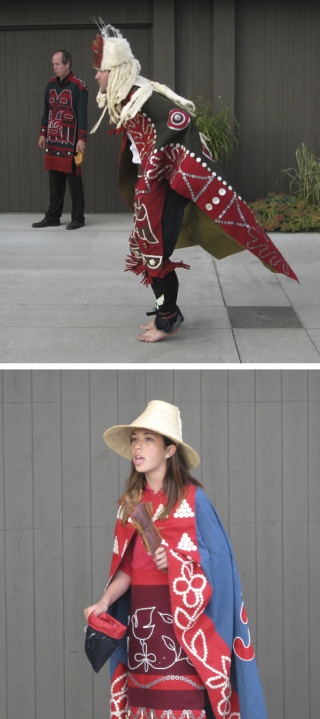By Theresa Simendinger
The blessing of two totem poles carved by First Nations artists Rande Cook and Calvin Hunt was filled with symbolism and significance.
At only 31, yet a new Kwaguilth chief, Cook danced as his daughter Jazmine, 13, sang in her first public performance of age-old traditional songs.
As Cook danced, eagle down fell from his headdress. He explained later as we watched it blow about in the warm breezes that eagle down brings peace and tranquility to all it touches, including the ground it falls on and all who walk on it.
Cook said the ceremony’s purpose was to bring the totem poles “alive” after being completed and placed in their new permanent home. He was thrilled that his daughter chose this time to come forward and perform the family’s traditional songs with him. Cook places only family above his art.
It was a double event for the prolific young artist.
Arctic Raven, the Native art gallery in Friday Harbor, showcased the artist in his first solo show; the show opened June 21 and continues through July 27.
Gallery owner Lee Brooks had been waiting for some time to focus a major show on Cook’s art and his diversity of media. At last, Cook felt what Brooks already knew — he was ready.
During the show’s opening, Cook, Hunt and John Livingston performed a welcome ceremony. Cook, to the delight of fans and onlookers, explained some of the meaning behind his different pieces.
Perhaps the most interesting was his explanation of three pieces on the wall: a painting in traditional style and colors, a line drawing symbolizing the traditional form line, and a framed wall piece which is a carving of an abstract orca in form line.
Cook related the inspiration for “Urban Tradition,” three square cedar boxes intricately carved to eye-level height and above. He said he was walking in downtown Victoria, gazing up at the high-rise buildings and he noticed that the bigger and more important the business, the bigger and fancier the buildings. He flashed back to the times of his ancestors and remembered the area was the site of their cedar homes and totem poles. The more important families would have bigger and more intricately carved totem poles.
These tall boxes are square like high-rises, but outlined in traditional exterior carvings to mark the similarity between the two societies.
The show’s centerpiece, “Box of Treasures,” is an intricately carved cedar box which symbolizes the boxes his ancestors used to transport family goods but, in this case, contains everything his people need: clothing, food, dance regalia, drums, light, shelter, tools.
Cook is charming and energetic and his art is well thought out, yet seems to come effortlessly to beautiful conclusions.
— Theresa Simendinger is a Journal correspondent.



